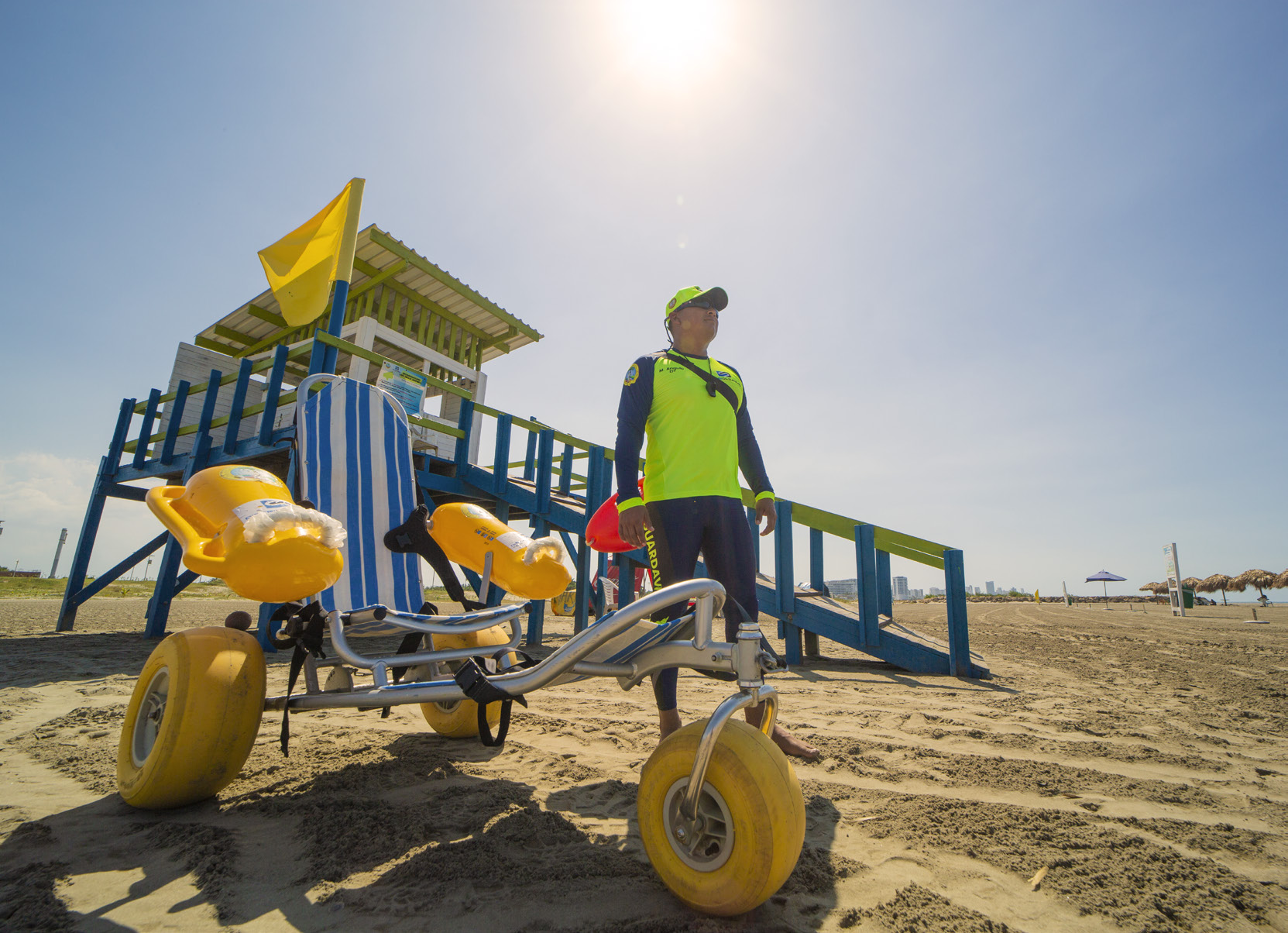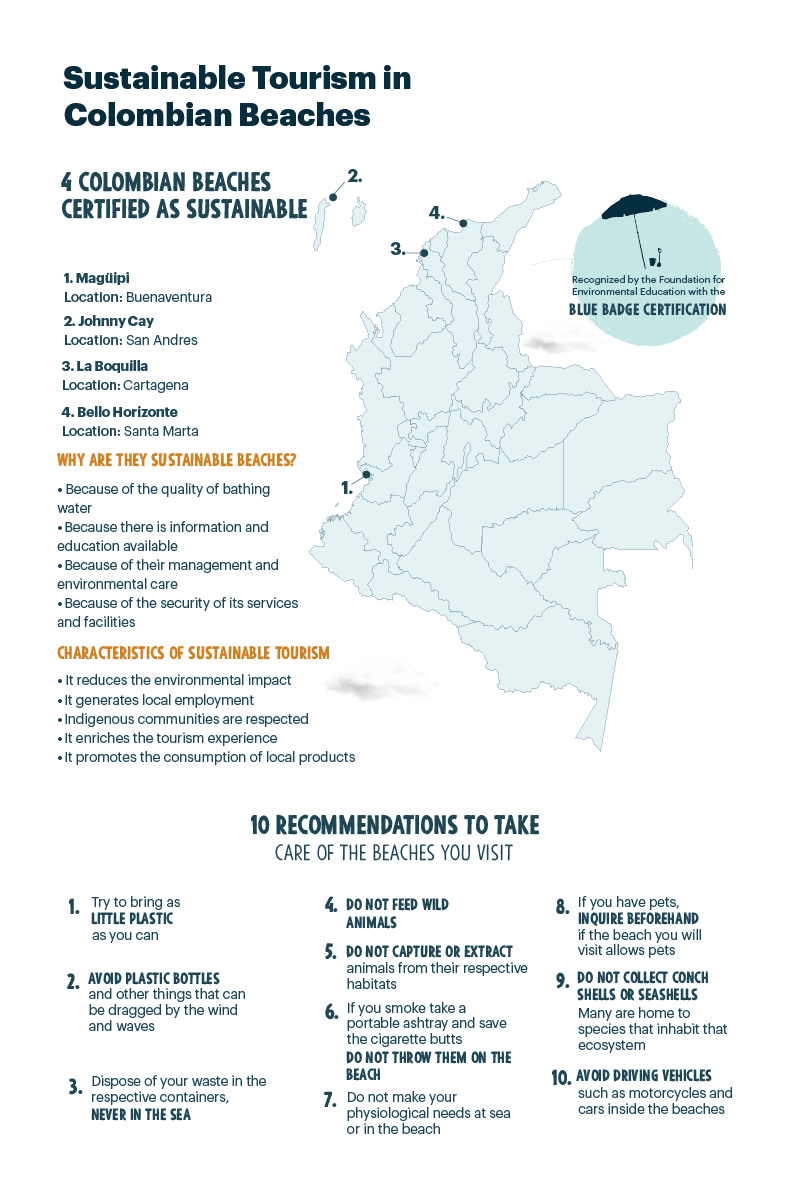La Boquilla
The Sustainable Beach of Cartagena de Indias
Towards the north of Cartagena you can live a whole new experience: beach days in front of a clean sea, a mangrove forest, fair prices and a host community working as a team to serve its visitors.
La Boquilla is a fishing village with Afro-Caribbean roots located in the northernmost point of Cartagena, a city that has been admired for its colonial architecture and engineering for decades. It is also a beach shelter for those looking to get away for a few hours from the turmoil of the Historic Center and the crowded beaches of Bocagrande. On a good day, the sun shines from the sky, appeased by an abundant sea breeze. Thin layers of dark gray sand rise and cover the visitors’ feet. Under that sky and sun, the beach opens up generously with its yellow tents and palm-roofed kiosks facing a green and crystalline blue sea.
To reach this 200-meter-long beach–which recently obtained one of the first four Blue Flag certificates in Colombia–you need to drive twenty minutes from the city center. The certification, received at the end of 2019, has been granted by the Foundation for Environmental Education (FEE) to more than four thousand beaches in the world since 1985. With this seal, La Boquilla guarantees that–in addition to being a natural and cultural treasure of the city–it has pure bathing waters, high safety equipment and sustainability protocols that care for the ecosystem, community and quality of the experience.
Starting at 7 AM, a team of natives greets the visitors. They provide, among others, rental services for tents, kiosks and sunshades. Forty-four restaurants, organized under a standardized price system, offer diverse drinks and food menus. In behalf of the tranquility of those who arrive in the middle of the morning, it is best to inform the hosts from the beginning what you will be having for lunch. We will always suggest the catch of the day: snapper, sawfish, mojarra, horse mackerel. Everything comes with coconut rice and plantain patacones.

In the basins of the fruit sellers walking along the beach during the day, you can find a dazzling rainbow to refresh the morning with watermelon, papaya, pineapple, mango, and bananas. In the afternoons, the sellers of traditional sweets roam the same way carrying desserts on their heads: cocadas, caballitos (papaya sweets), alegrías (corn and coconut sweets), enjucados (cassava and coconut sweets).
With palm trees and a few hotels and condominiums behind, anyone looking from their sun chair to the horizon finds a long and lonely cyan strip that, if not for the buoys that limit the bathing area, seems to stretch to infinity. In the distance, next to it, a parade of colorful kite surf kites glides over the blue palette. The breeze season goes from December to May, but in La Boquilla there is wind all year long, therefore, seven kite surf and paddle schools offer their services to those interested. They offer courses for beginners from one, three and five hours, ranging from 50 to 250 dollars, and multi-day plans for the more advanced.
If you are looking for a break, in La Boquilla there is a massage therapist collective made up of people who, before the Blue Flag certification, worked by their own on the beach. Now they are a team of more than household-leading women who were trained to offer therapeutic massages and have friendly and professional infrastructure on the sand. The massages can range from 5 to 20 dollars and can be accompanied by fresh fruits, natural juices and other beverages. For those who knew the old days of La Boquilla, the enjoyment space is now wider; security is more visible with its police monitoring posts and trained lifeguards. The seller and masseuse offer is also more orderly than in the past and even in other beaches of the city. “You feel the community work,” says a Bogota tourist relaxing on the shore with his family during on December morning.
Did you know that in San Andres lies on the third largest barrier reef in the world?
If you have come this far, you already know it’s all about contemplation, sand and sea. It is time to explore one of the most passionate journeys of Cartagena. Passing the sand cordon of the beach is the Cienaga de La Virgen, a 193 square mile coastal lagoon connected to the city bay through pipes and internal lakes. La Cienega is a forest where three different mangrove species live, the endemic blue crab and dozens of bird species such as the cattle egret, the scarlet ibis and the northern shoveler.
In order to visit this Eden, you can go to any of the three community tourism organizations and ecotours that offer varied experiences to the curious. It is possible, for example, to go out after dawn with the community fishermen, assemble the nets to catch crabs and fish and finish the morning off with a good stew in the heart of La Boquilla. Another possibility in the Cienega is the sighting of both native and migratory birds that takes place at dawn or in the late afternoon. In any case, the plan begins with cold coconut water that will quench your thirst.


The departure is on the beach on artisanal canoes entering the forest through the sea.
Once inside, the beach and the street sounds disappear and there is but silence and the breeze caressing the leaves of the bushes. The canoe floats on the flat green and thick waters, led by a native guide of the village that–as it travels through the spontaneous streets that the mangrove has built–tells stories about the flora and fauna of the place. Crustaceans, mollusks, small mammals and fish are there along the journey through tunnels named by the moods they arise in those who visit them: Love, Happiness, Bliss, Pleasure.
The journey continues through the Juan Angola lagoon where bird watching takes place and some tours offer the option of planting mangrove seedlings to make the forest grow. The afternoon falls on the sea while the canoe returns to the beach after two or four hours according to the travel schedule.
The end of the day in Playa Azul closes with the sunset, which ceases before six in the afternoon. One ends with the feeling of having left another place, another Cartagena, one hidden behind the fantastic colonial narratives, reigns and purchases behind. Beyond the walls an oceanic world of a city composed by lagoons, islands and pipes unfolds. Facing the new face of La Boquilla, Cartagena becomes a new city to discover.

La Boquilla, Cartagena de Indias.
Text by Teresita Goyeneche
























